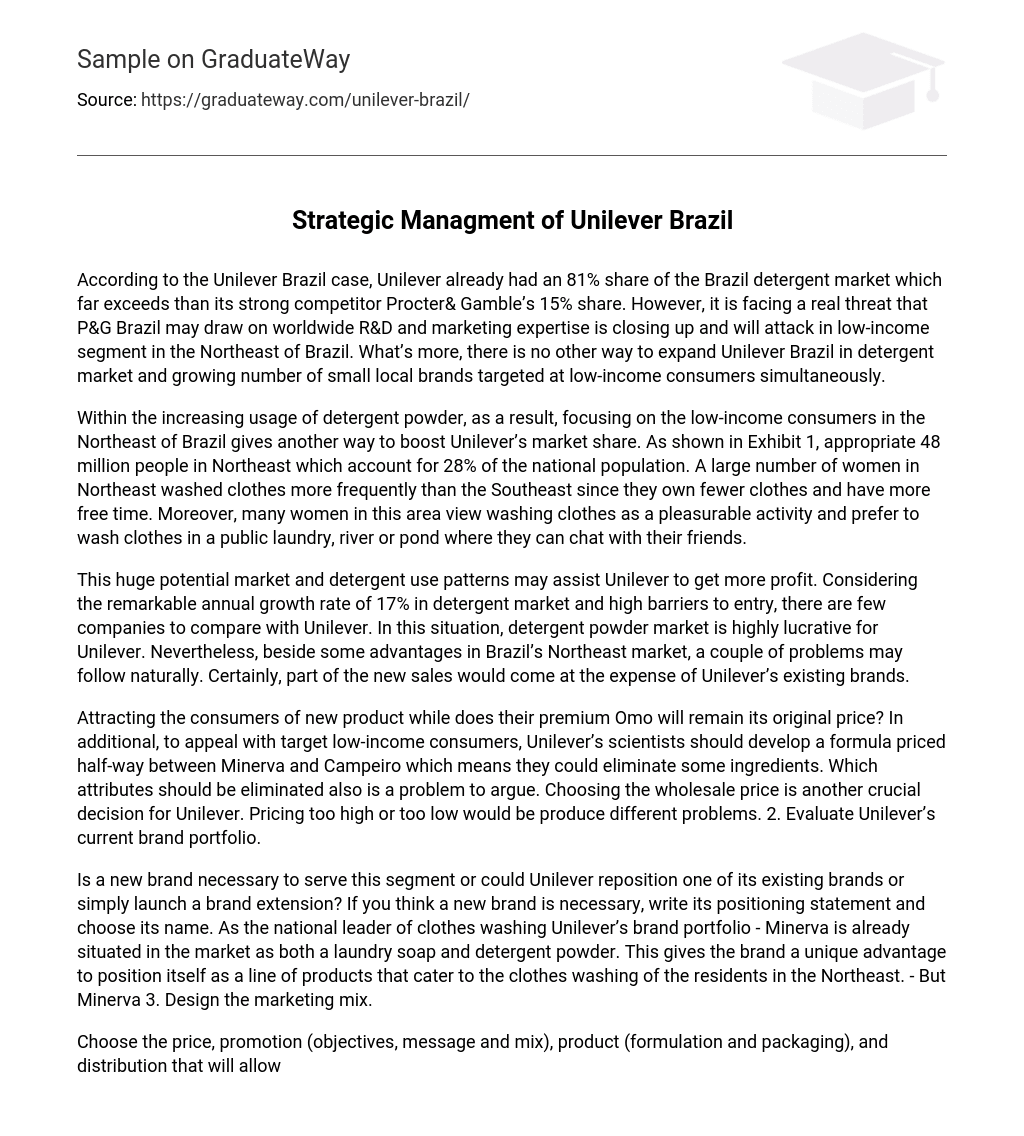According to the Unilever Brazil case, Unilever already had an 81% share of the Brazil detergent market which far exceeds than its strong competitor Procter& Gamble’s 15% share. However, it is facing a real threat that P&G Brazil may draw on worldwide R&D and marketing expertise is closing up and will attack in low-income segment in the Northeast of Brazil. What’s more, there is no other way to expand Unilever Brazil in detergent market and growing number of small local brands targeted at low-income consumers simultaneously.
Within the increasing usage of detergent powder, as a result, focusing on the low-income consumers in the Northeast of Brazil gives another way to boost Unilever’s market share. As shown in Exhibit 1, appropriate 48 million people in Northeast which account for 28% of the national population. A large number of women in Northeast washed clothes more frequently than the Southeast since they own fewer clothes and have more free time. Moreover, many women in this area view washing clothes as a pleasurable activity and prefer to wash clothes in a public laundry, river or pond where they can chat with their friends.
This huge potential market and detergent use patterns may assist Unilever to get more profit. Considering the remarkable annual growth rate of 17% in detergent market and high barriers to entry, there are few companies to compare with Unilever. In this situation, detergent powder market is highly lucrative for Unilever. Nevertheless, beside some advantages in Brazil’s Northeast market, a couple of problems may follow naturally. Certainly, part of the new sales would come at the expense of Unilever’s existing brands.
Attracting the consumers of new product while does their premium Omo will remain its original price? In additional, to appeal with target low-income consumers, Unilever’s scientists should develop a formula priced half-way between Minerva and Campeiro which means they could eliminate some ingredients. Which attributes should be eliminated also is a problem to argue. Choosing the wholesale price is another crucial decision for Unilever. Pricing too high or too low would be produce different problems. 2. Evaluate Unilever’s current brand portfolio.
Is a new brand necessary to serve this segment or could Unilever reposition one of its existing brands or simply launch a brand extension? If you think a new brand is necessary, write its positioning statement and choose its name. As the national leader of clothes washing Unilever’s brand portfolio – Minerva is already situated in the market as both a laundry soap and detergent powder. This gives the brand a unique advantage to position itself as a line of products that cater to the clothes washing of the residents in the Northeast. – But Minerva 3. Design the marketing mix.
Choose the price, promotion (objectives, message and mix), product (formulation and packaging), and distribution that will allow Unilever to create and capture value for low-income consumers in NE Brazil. Product: According to the case, the cheapest product Campeiro (wholesale price:$1. 70)do not provide the attributes that demanded by the NE segment . Unilever could produce a new brand-S, which could not only comparable to Camperio, but also meet the requirements of low-income consumers. (Unilever may also launch a brand which already satisfy the most need of low income consumer in other countries.
For example, it can introduce some product that is popular in Latin America into Brazil. Because low-income consumers of Latin American and Brazil have similar cultural background and needs). The new product would be in line with attributes that are most important to consumers. Learning from the section” How do Northeastern Consumers Evaluate Detergents? ” we know that consumer often associate a strong demand of product’s smell and softness, the perceived power of the detergent and the dissolving power. While S is pursuing a low cost strategy, the long-term strategic goal is to dominate the NE Brazil market.
Within this in mind, Unilever would give up the 30% saving of using plastic sachet. Moreover, considering about the weekly budget of the poorest consumers, S will be sold in 1kg and500g with cardboard boxes. Promotion: As we know from the case, the illiteracy rate of NE consumers is more than 40% and many women in the NE view washing clothes as one of the more pleasurable activities of their week. Promotion will rely heavily on producing imagery message to communicate with customers. That imagery must be funny and impressive so that women would talk about those things while they are using S products.
Moreover, Unilever could produce some slogans that based on the symbolic value NE people attach to cleanses. For example, the slogan can be “Using S, you will have a brighter life. ” Promotions could also be advertising via television and billboard. Distribution: We are been told that Unilever is unable to distribute to the 75,000 small outlets over the Northeast. Unilever can build a partnership with specialized distributors, which have 24-40 SKU’s. Based on the relationship with those distributors, Unilever could gain much information about the marketing of NE market.
However, if this agreement threatened the distribution of OMO and Minerva, Unilever have to build its distribution line through General Wholesalers. Price: (those statistics is based on the exhibition given by the case analysis. ) As we mentioned in paragraph 1,compare to Camperio, S will focus more on quality. So the formulation cost of S is $1. 1 per kg. Using the cardboard packaging, the packaging cost is $0. 35 per kg. The promotion cost is $0. 20 and the total cost is 1. 65 and the wholesale price is 1. 85. 4. What would be the profitability of your proposal (calculate the margins)? What is the break even cannibalization rate?





